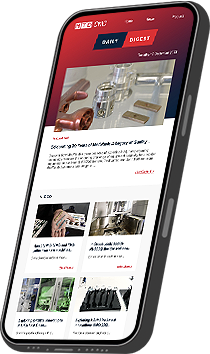
Advanced CT Scanning
Industry-leading computed tomography (CT) scanning technology provided by Nikon has been employed to uncover the secrets…

Sustainability considerations are currently ‘trendy’ and Individual elements such as toolholding are often considered. However, if you want to act sustainably, you should not focus too much on finite details and look at the overall process. When it comes to sustainability, the product life cycle and the process in which it is integrated are critical factors.
In machining, there are a lot of variables to consider such as the material, component geometry, quantities, type of machine, tools and clamping devices used. External circumstances such as the production location, the qualifications of the employees and automation must also be considered.
Apart from materials, energy efficiency is probably the main factor that determines a sustainable process. Therefore, a promising approach is to look for the largest consumers and optimise their use. The machine tool offers savings potential as it consumes the majority of the energy used with its spindle and axis drives, peripherals and auxiliary units.
When purchasing new machines, the user can significantly reduce consumption by paying attention to energy-saving components. Andreas Haimer, Managing Director and President of the HAIMER Group, explains: “In our production, we have learned that replacing an old machining centre with a new one using the same machining process requires around 30% less energy. As a family business, we pay a lot of attention to sustainability. In the last financial year, we invested a total of over €1m and we have saved over 250 tons of CO2.”
Machining savings can be made with examples like CAD/CAM-optimised machining strategies. Andreas Haimer says: “A customer provided us with data on how he reduced machining time by 75% from 71 to 18 minutes per part by trochoidal milling with our HAIMER Power shrink fit chucks and the HAIMER MILL cutters. The change in machining strategy was accompanied by energy savings due to significantly lower power consumption. While the spindle load was 80-85% for 10 parts with a face mill that had a total energy cost of around €150, the trochoidal milling strategy with a spindle load of 8-10% and shorter cycle time reduced energy costs to €5 for 10 parts. This was a higher output with lower energy consumption per part produced.”
The sustainability
of toolholding
Have you ever thought about how a tool holder could contribute to sustainability? Where a milling machine consumes an average of around 30kW, plus the power of hydraulic and pneumatic devices, automation equipment and robots – toolholding only plays a subordinate role. This is because the tool holder is a comparatively small detail, even if using a shrink-fit chuck with a marginal energy consumption.
Looking at other clamping systems, the energy consumption during shrinking is higher in operational use than with a hydraulic or milling chuck. Looking at the entire product life cycle of a tool holder, which includes production, maintenance and disposal, a completely different picture emerges.
The production of a hydraulic chuck requires significantly more effort and energy due to its complicated structure. There is also the soldering of the expansion sleeve, additional heat treatment to prevent the solder joint from breaking, as well as the effort required for cleaning, assembly and filling with oil. “From our experience, the energy required for production is around three times higher for the shrink-fit chuck,” explains Andreas Haimer.
“In addition to shrink-fit chucks, we also have hydraulic chucks. Although their list prices are higher than shrink-fit chucks, they are the right solution for certain applications. However, they are not more sustainable. Our analyses show that a hydraulic chuck requires around 25kWh more energy to manufacture than a shrink chuck. In product life cycle terms, a shrink fit chuck with an energy requirement of 0.026kWh per shrink fit and the cooling cycle can be shrunk almost 1,000 times before it requires more energy than a hydraulic chuck.”
The same applies to milling chucks, which are much more complicated and contain more components as well as grease and lubricants. Life cycle and process reliability are crucial. Haimer shrink chucks are maintenance-free and can be shrunk in and out an unlimited number of times, whereas hydraulic chucks and milling chucks have to be serviced every 2-3 years to check the clamping force. The contained hydraulic fluid or grease also makes environmentally friendly disposal more difficult than with shrink-fit chucks. As well as the life cycle, there are differences in terms of process reliability.
But how is energy consumption calculated during the shrinking process? Heating a shrink-fit chuck takes about 5 seconds. The maximum output of a HAIMER Power Clamp shrink-fit machine is 13kW, but the average is 8kW. This means that a single, complete shrinking process consumes around 0.011kWh and cooling consumes 0.015kWh resulting in a total of 0.026kWh. If a kilowatt-hour costs 20 cents, shrinking and cooling costs a marginal 0.5 cents. How should the energy consumption be classified when considering the machining process with a power consumption of around 30kW? Assuming that a tool is in use for an hour and 1% machining time can be saved thanks to the high concentricity and rigidity or the improved milling strategies due to the slim contour holder, that would be 0.3kWh of energy saved.
Andreas Haimer summarises: “The energy consumption per clamping process plays a negligible role compared to the issues of life cycle and machining strategy. Modern CAD/CAM-optimised milling strategies can save 75% of machining time. Machinists must focus on such processes if they want t sustainability and productivity.”

Stay up to date with the latest industry news and events.

Be first to see all the updates from MTDCNC
Our newsletters frequency varies dependant on content
All the latest deals from the industry feature on our newsletters